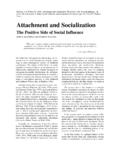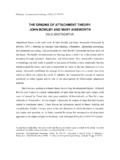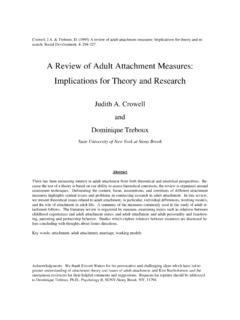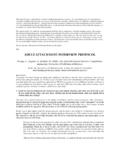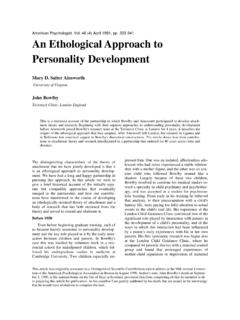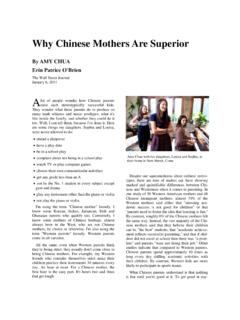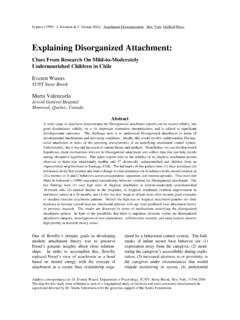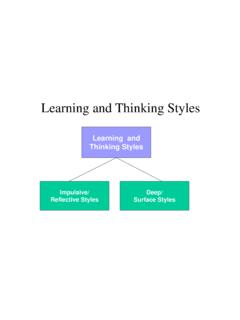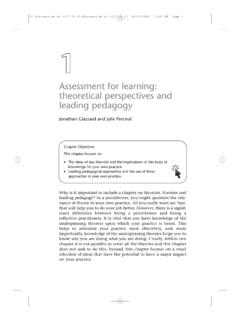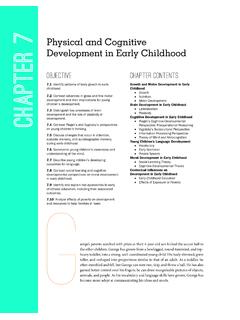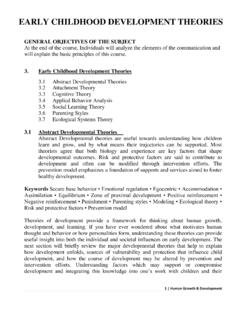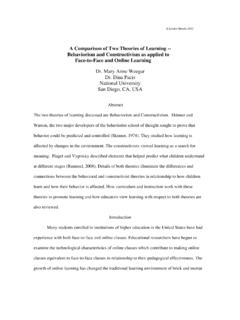Transcription of Cognitive and Language Development - Stony Brook
1 Cognitive and Language DevelopmentProcesses and PeriodsDevelopmental IssuesWhat is Development ?An Overview ofChildDevelopmentAn Overview of Child DevelopmentDevelopment: The pattern of biological, Cognitive , and socioemotional changes that begins at conception and continues through the life IssuesNature-Nurture IssueContinuity-Discontinuity IssueEarly-Later Experience IssueCognitive and Language DevelopmentCognitive DevelopmentPiaget s TheoryThe BrainVygotsky s theory Role of early and later experiences Myelination of Neurons with age Dramatic changes in synaptic connections Prefrontal cortex Development into adolescence Brain functioning occurs along specific pathways and involves integration of functionBrain Development Early & later experiences.
2 Including educational experiences, influence brain Development Development at the highest level of the brain the prefrontal cortex, continues at least through the adolescent years There is a great of hype and hyperbole about brain Development & learning in the mediaBrain and Children s EducationPiaget s theory Basic ConceptsSchemasAssimilationAccommodation OrganizationEquilibrationActions or mental representations that organize knowledgeIncorporating new information into existing schemasAdjusting existing schemas to fit new information and experiencesGrouping isolated behaviors and thoughts into a higher-order systemA shift.
3 A resolution of conflict to reach a balanceExample of Assimilation & AccommodationA two year old encounters a man who is bald on the top of his head and has long, frizzy hair growing out from each side. The child gleefully shouts Clown, clown. Dad tells his child that the man is not a clown, even though his hair is like a clown s. The man was not wearing a funny costume and wasn t trying to make people initially assimilates the man to his concept of a clown. After feedback from Dad the child accommodates his idea of clown to the concept s standard unfolds in a sequence of four stages.
4 Each stage is age-related and distinctive. Each stage is discontinuous from and more advanced than the s Stage ModelPiaget s Four StagesCoordination of sensory experienceswith motor actions. Thought is Action Object permanenceinvolves the realization that objects continue to exist over s Sensorimotor StagePiaget s Preoperational StageSymbolic Thought: Ability to represent mentally an object that is not : Egocentrism: The inability to distinguish between one s own perspective and someone else s with spatial perspective takingProblems with social perspective takingThe Three Mountain TasksPre-operational Period: Egocentric SpeechMary: They wiggle sideways when they : (vaguely) What?
5 Mary: My bunny slippers. They are brown and red and sort of yellow and : I have a piece of sugar in red pieces of paper. I m gonna eat it and maybe its for a horse. Mary: We bought them. My mom did. We couldn t findthe old ones. They were in the : Can t eat the piece of sugar, not unless you take thepaper : And we found Mother Lamb. Oh, she was in Pough-keepsie in the trunk in the house in the : Do you like sugar? I do, and so do s Preoperational StageMore Limitations: Centration: Focuses on one characteristic to the exclusion of of ConservationClassification:Ability to classify objects according to only onecharacteristic at a of LiquidConservation of Solid Substance: Is there more, less, or same amount of clay?
6 Conservation of Liquid Substance: Is there more, less, or same amount of blue liquid?Conservation of Number: Are there more, fewer, or same number of spheres?Piaget s Concrete Operational StageConservationThe idea that some characteristics of an object stay the same even though the object might change in several characteristics rather than focus on a single property of an stimuli along some quantitative relations to understand certain >B, andB>C, thenA> reasoningreplaces intuitive reasoning, but only in concrete Classes & RelationsPiaget s Formal Operational StageAbstract reasoning: Think in abstract, idealistic, and logical reasoning.
7 Ability to develop hypotheses about ways to solve problems and systematicallyreach a :Ability to reflect on one s own Cognitive egocentrism:Heightened self-consciousness and a sense of personal uniqueness. 1,2,3,and 4 contain colorless, odorless liquids. X contains an activating solution . Some combination of liquids (always including X)will give a YELLOW color. How can you find the combination thatmakes YELLOW?Jean Piaget: Mixing Colors ProblemClassic ProblemJean Piaget (1896-1980)Children s Cognitive DevelopmentUniversity of Geneva1234 XJean Piaget: Mixing Colors ProblemClassic ProblemJean Piaget (1896-1980)
8 Children s Cognitive DevelopmentUniversity of Geneva1+x2+x3+x4+x1+2+x1+3+x1+4+x2+3+x2+ 4+x3+4+x1+2+3+x1+2+4+x1+3+4+x2+3+4+x1+2+ 3+4+x Estimates of children s competence Stages Training children to reason at a higher level Culture and educationCriticisms of Piaget s TheoryPiaget s Key ContributionVision of children as active, constructive thinkers Take a constructivist approach Facilitate rather than direct learning Consider the child s knowledge and level of thinking Turn the classroom into a setting of exploration and discoveryOverall Teaching Recommendations - Piaget
